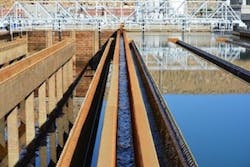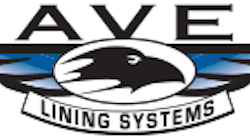The Escondido-Vista Water Treatment Plant in Escondido, Calif., supplies water to over 25,000 residential, commercial and agricultural customers. As the city has steadily grown, the water treatment plant’s aging infrastructure has deteriorated.
Upon inspection of the facility, it was concluded that the plant’s 90,000 sq ft of concrete showed signs of degradation with exposed aggregate. Officials decided to rehabilitate the current facility rather than build a new one in order to save taxpayers’ money.
National Coating and Lining Company (NCLC), a Raven certified applicator, won the project. Based in Murrieta, Calif., NCLC offers 40 years of combined expertise in the restoration and protection of concrete and ferrous metals throughout the water and wastewater industry, so it was an exceptional fit for the type of project envisioned for Escondido.
Challenges
The biggest challenge associated with the project was accommodating the city’s needs while completing a 150-day project in 60 days. The overall goal was to limit the time the plant was affected in order to continue to provide an adequate water supply to the city with the summer approaching.
In addition, the process of applying coating was restricted to times when temperatures were relatively low—typically during late-night shifts to aid in diminishing moisture vapor transmission. Also, coating concrete with an excessively rough surface profile without a cementitious resurfacing proved difficult, and workers had to contend with minor infiltration.
“NCLC opted to increase the film thickening from the specified 80 mm to 160 mm in lieu of concrete restoration in order to expedite the completion date,” said Tom Unsell, NCLC vice president. “To accommodate for the accelerated turn-around, we increased manpower and equipment, as well as working nights.”
Solutions
The surface of the structure was degrading due to the chemicals used in water treatment. After the City of Escondido assessed the facility, it was determined that a 100% epoxy product—which must be NSF/ANSI 61-certified—would protect and reinforce the structure from further deterioration. The technology to be used by NCLC would be a fluid-applied plural component 100% solids epoxy, in lieu of a cementitious underlayment with an epoxy topcoat. Using AquataPoxy as the resurfacer and epoxy topcoat would allow faster turnaround while providing a superior coating system.
Eliminating cementitious repair saved time and money—workers did not have to wait for the concrete to cure, and a secondary surface preparation of the cementitious repair was eliminated. By utilizing the coating over a rough substrate, adhesion to the structure was increased and structural integrity was reinforced.
In addition, two times the millage increased thickness of the polymer and allowed for improved resistance to hydrostatic loading and additional abrasion resistance. It also increased the service life of the structure.
Process
The basins were drained, and all remaining solids and debris were physically removed. A combination of a 5,000-psi hydro-blast and abrasive blasting was performed over entire structure, with the goal to achieve a minimum concrete surface profile of CSP-3. At the edge of where the coating application ceased, termination grooves and keyways were utilized to assure that superior adhesion existed. After completing surface preparation, a final low-pressure water rinse was conducted to wash away the loose dust and debris. After the substrate had dried, two coats of primer were applied to reduce moisture vapor transmission. The first coat of AquataPoxy A6 Thick was applied with a back trowel to smooth the surface of the coating, and once that coat was tack-free, a second coat was applied. Any pinholes found after holiday testing were repaired within the recoat window; pinholes discovered after the recoat window had expired were prepared and then repaired according to Raven recommended procedures.
The solution implementation benefits the City of Escondido by providing an increased service life of the structure, as well as protecting the life of the investment. The cost of the project was $1.2 million.
Roxanne Cook is the director of marketing for Raven Lining Systems. Cook can be reached at [email protected].



